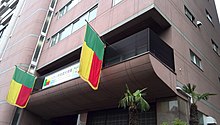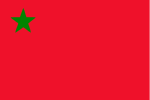Flag of Benin
| Flag of Benin | |
|---|---|
 |
|
| Vexillological symbol : |
|
| Aspect ratio: | 2: 3 |
| Officially accepted: | First introduced on December 4, 1958 Re-introduced: August 1, 1990 |

The flag of Benin was introduced on December 4, 1958 as the flag of the then Dahomey , which had become autonomous from France .
meaning
The colors are the traditional Pan-African colors , green symbolizing hope, yellow prosperity and red courage. Interpreted differently, green represents the fertile south, yellow the savannahs in the north, red the land and the blood shed by previous generations.
history
Even before the conquest of the region by France , the kings of Dahomey used flags. King Ghezo (1818-1858) wielded a white flag with a crowned elephant and red border. King Béhanzin (1889 to 1892) had a light blue flag with a yellow shield on which a gray shark, a white egg and tusks, a green palm tree, light green snakes and a white ribbon could be seen. This flag was captured by the French on November 18, 1892.
The current flag was retained after independence in 1960. After the coup by Mathieu Kérékou , the country was renamed Benin in 1975 . The flag was also changed according to the new Marxist-Leninist system of government and based on the model of the party flag. It consisted of a green cloth and a five-pointed red star in the jack. The green symbolized the agrarian state of Benin, the red star revolution, socialism and national unity.
After the end of the communist government, the old flag was reintroduced on August 1, 1990.
Web links
- Flags of the World - Benin (English)


